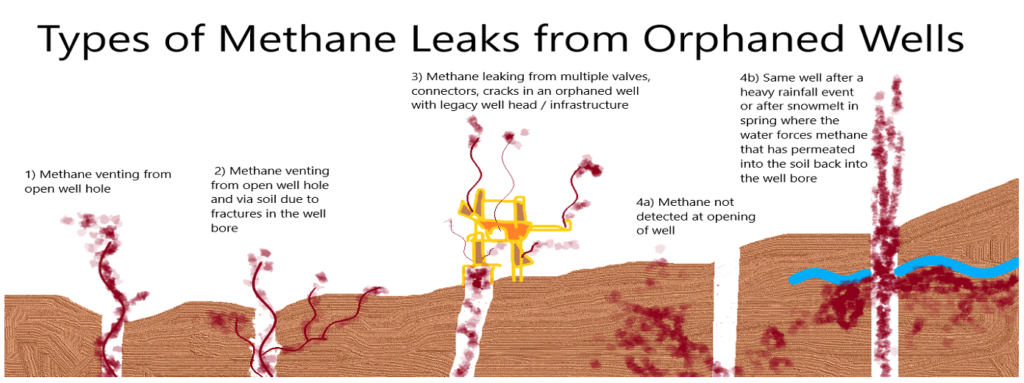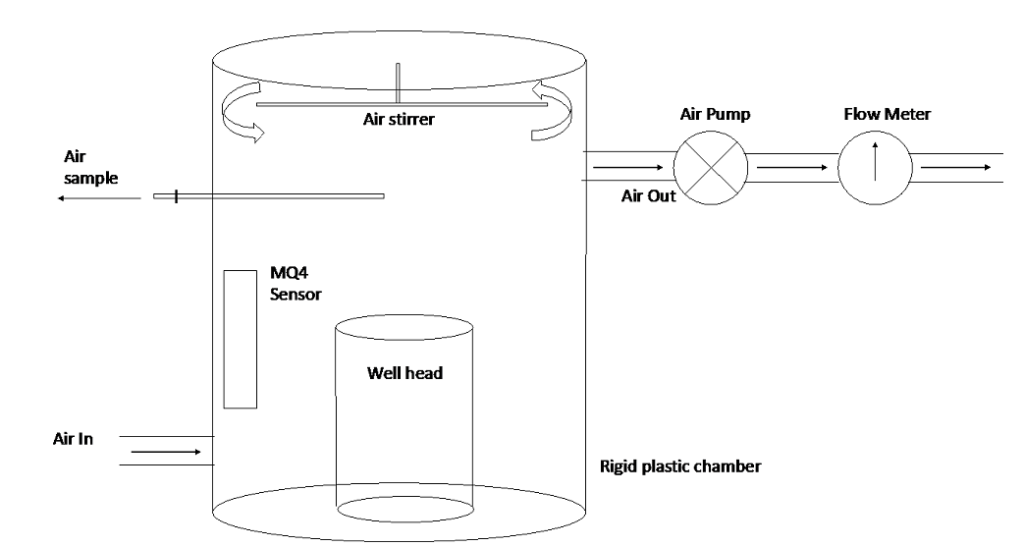Colorado Orphaned and Abandoned Wells Study

Introduction:
Methane is a powerful greenhouse gas and the largest component of natural gas. Bottom-up approaches estimate 6 Tg of methane is emitted from US natural gas systems each year, this includes emissions from production, processing, transmission, storage and distribution (US EPA, 2018). Discrepancies between top-down and bottom-up methane emission estimates have been identified (Caulton et al., 2014; Schwietzke et al., 2014; Zavala-Araiza et al., 2015), and recent studies suggest inventories may be missing sources (Zavala-Araiza et al., 2015) or emission variability may exist (Lavoie et al., 2017) resulting in unrepresentative emission factors used to generate bottom up estimates from active methane extraction processes (Nisbet and Weiss, 2010; Nisbet et al., 2019).
One recent addition to the US Greenhouse Gas inventory is methane emissions from abandoned oil and gas wells. Emission factors used in the inventory are based on US measurement studies, conducted mainly in Eastern US states (Kang et al., 2016; Omara et al., 2016; Pekney et al., 2018; Riddick et al., 2019; Townsend-Small et al., 2016). The term “abandoned well” encompasses a range of types of wells:
- Wells with no recent production, and not plugged (Figures 1.1 and 1.2). Terms include inactive, temporarily abandoned, shut-in, dormant, idle.
- Wells with no recent production and no responsible operator. Terms include orphaned, deserted, long-term idle, abandoned (Figure 1.3).
- Wells that have been plugged to prevent migration of gas or fluids (Figure 1.4).
Average methane emissions from unplugged abandoned wells in the Appalachian Basin are reported as 3 g CH4 h−1 well−1 in West Virginia (Riddick et al., 2019), 17 g CH4 h−1 well−1 in Pennsylvania (Kang et al., 2016), and 28 g CH4 h−1 well−1 in Ohio (Townsend-Small et al., 2016). This suggests that differences in operator practices, state law and/or regulation could lead to significant differences in average emissions from abandoned wells. At present, few data exist on methane emissions from abandoned oil and gas well in Colorado. Therefore, it is unclear which emissions factor should be used to calculate statewide emissions from abandoned wells. Also, the are no data to indicate how the average age of wells in Colorado, environmental conditions, operator’s practices, state regulations and post-abandonment activities could affect the average emission from abandoned wells.
Aims:
This study will focus on marginal (1 BOE/day production), orphaned wells (non-producing) and plugged and abandoned wells in Colorado to generate a regionally representative range of emissions from each type of well. Specifically, the objectives of the proposed study are to:
- Update a literature review on regional variability in methane emissions from abandoned oil and gas wells.
- Conduct a field study to collect emissions data from marginal, orphaned, and plugged and abandoned wells in Colorado.
- Report findings of the field study.
Methodology:
The project started on the 24th August 2022 and consists of two parts, an updated literature review and a field measurements component.
The literature review will look at most recent studies on orphaned wells to determine relative emission rates of marginal (1 BOE/day production), orphaned (non-producing) and plugged and abandoned wells in different regions of the world.
The field measurement component will comprise measuring emission from at least 320 orphaned wells in Colorado. During the field measurements, each site will be screened using an ABB Micro-portable Greenhouse Gas Analyzer (MGGA; 1-sigma CH4 precision < 0.9 ppb over 1 sec; range 0 to 100 ppm). Screening will include the wellhead, failure at wellbore, and any still-attached flow lines that may leak some distance away from the well head.
If a methane enhancement above background is detected, the emission will be quantified using a dynamic chamber (Figure 2; Riddick et al., 2020, 2019). Methane concentrations inside the chamber will be measured in real-time using an SGX integrated infra-red (INIR) INIR-ME100% sensor (Uncertainty ± 6%; range 100 ppm to 100% bv.) mounted inside the chamber. Both the chamber and the INIR sensor will be calibrated at Colorado State University’s Methane Emission Technology Evaluation Center (METEC) in Fort Collins. The dynamic chamber has been shown to calculate emissions to an uncertainty of ±7% (Riddick et al., 2022). Data from the INIR sensor will be collected to a laptop at the sampling site.

For emission sources that cannot fit inside the chamber we will use a downwind method to quantify emissions. This method uses methane concentrations measured by the MGGA 5 m downwind of the source in a backward Lagrangian stochastic (bLs) model to infer the emission. The bLs method has been validated at METEC, has an associated emission uncertainty of ±12% (Riddick et al., 2022) and was used to measure emissions from similar sources in West Virginia (Riddick et al., 2019).
Sampling will range from 1 to 5 wells per day depending on location, access, geographic location, etc. Outcomes of the project will be presented in written reports and data deposited in an open-access repository at CSU (Mountain Scholar).
References:
Caulton, D.R., Shepson, P.B., Santoro, R.L., Sparks, J.P., Howarth, R.W., Ingraffea, A.R., Cambaliza, M.O.L., Sweeney, C., Karion, A., Davis, K.J., Stirm, B.H., Montzka, S.A., Miller, B.R., 2014. Toward a better understanding and quantification of methane emissions from shale gas development. Proceedings of the National Academy of Sciences 111, 6237–6242. https://doi.org/10.1073/pnas.1316546111
Kang, M., Christian, S., Celia, M.A., Mauzerall, D.L., Bill, M., Miller, A.R., Chen, Y., Conrad, M.E., Darrah, T.H., Jackson, R.B., 2016. Identification and characterization of high methane-emitting abandoned oil and gas wells. Proceedings of the National Academy of Sciences 113, 13636–13641. https://doi.org/10.1073/pnas.1605913113
Lavoie, T.N., Shepson, P.B., Cambaliza, M.O.L., Stirm, B.H., Conley, S., Mehrotra, S., Faloona, I.C., Lyon, D., 2017. Spatiotemporal Variability of Methane Emissions at Oil and Natural Gas Operations in the Eagle Ford Basin. Environmental Science & Technology 51, 8001–8009. https://doi.org/10.1021/acs.est.7b00814
Nisbet, E., Weiss, R., 2010. Top-Down Versus Bottom-Up. Science 328, 1241–1243. https://doi.org/10.1126/science.1189936
Nisbet, E.G., Manning, M.R., Dlugokencky, E.J., Fisher, R.E., Lowry, D., Michel, S.E., Myhre, C.L., Platt, S.M., Allen, G., Bousquet, P., Brownlow, R., Cain, M., France, J.L., Hermansen, O., Hossaini, R., Jones, A.E., Levin, I., Manning, A.C., Myhre, G., Pyle, J.A., Vaughn, B.H., Warwick, N.J., White, J.W.C., 2019. Very Strong Atmospheric Methane Growth in the 4 Years 2014–2017: Implications for the Paris Agreement. Global Biogeochem. Cycles 33, 318–342. https://doi.org/10.1029/2018GB006009
Omara, M., Sullivan, M.R., Li, X., Subramanian, R., Robinson, A.L., Presto, A.A., 2016. Methane Emissions from Conventional and Unconventional Natural Gas Production Sites in the Marcellus Shale Basin. Environmental Science & Technology 50, 2099–2107. https://doi.org/10.1021/acs.est.5b05503
Pekney, N.J., Diehl, J.R., Ruehl, D., Sams, J., Veloski, G., Patel, A., Schmidt, C., Card, T., 2018. Measurement of methane emissions from abandoned oil and gas wells in Hillman State Park, Pennsylvania. Carbon Management 9, 165–175. https://doi.org/10.1080/17583004.2018.1443642
Riddick, S.N., Mauzerall, D.L., Celia, M.A., Kang, M., Bressler, K., Chu, C., Gum, C.D., 2019. Measuring methane emissions from abandoned and active oil and gas wells in West Virginia. Science of The Total Environment 651, 1849–1856. https://doi.org/10.1016/j.scitotenv.2018.10.082
Schwietzke, S., Griffin, W.M., Matthews, H.S., Bruhwiler, L.M.P., 2014. Natural Gas Fugitive Emissions Rates Constrained by Global Atmospheric Methane and Ethane. Environmental Science & Technology 48, 7714–7722. https://doi.org/10.1021/es501204c
Townsend-Small, A., Ferrara, T.W., Lyon, D.R., Fries, A.E., Lamb, B.K., 2016. Emissions of coalbed and natural gas methane from abandoned oil and gas wells in the United States: METHANE EMISSIONS FROM ABANDONED WELLS. Geophysical Research Letters 43, 2283–2290. https://doi.org/10.1002/2015GL067623
US EPA, 2018. Inventory of U.S. Greenhouse Gas Emissions and Sinks: 1990-2016 [WWW Document]. US EPA. URL https://www.epa.gov/ghgemissions/inventory-us-greenhouse-gas-emissions-and-sinks-1990-2016 (accessed 1.29.19).
Zavala-Araiza, D., Lyon, D.R., Alvarez, R.A., Davis, K.J., Harriss, R., Herndon, S.C., Karion, A., Kort, E.A., Lamb, B.K., Lan, X., Marchese, A.J., Pacala, S.W., Robinson, A.L., Shepson, P.B., Sweeney, C., Talbot, R., Townsend-Small, A., Yacovitch, T.I., Zimmerle, D.J., Hamburg, S.P., 2015. Reconciling divergent estimates of oil and gas methane emissions. Proceedings of the National Academy of Sciences 201522126. https://doi.org/10.1073/pnas.1522126112
Publication:
29 February 2024 – Methane emissions from abandoned oil and gas wells in Colorado
Stuart N. Riddick, Mercy Mbua, Arthur Santos, Ethan W. Emerson, Fancy Cheptonui, Cade Houlihan, Anna L. Hodshire, Abhinav Anand, Wendy Hartzell, Daniel J. Zimmerle (PDF)
